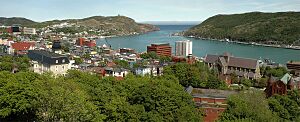The Narrows, St. John's facts for kids

The Narrows is a very important passage in Newfoundland, Canada. It is the only way for ships to get from the Atlantic Ocean into St. John's Harbour. This passage is surrounded by tall, rocky cliffs on both sides.
Navigating through The Narrows is tricky! It's so narrow that captains of large ships need to be very skilled. People often call it "threading the eye of a needle" because it's such a tight fit. At its narrowest point, near a spot called Chain Rock, it's only about 61 metres wide. The water is at least 11 metres deep, which is enough for many ships.
For a long time, starting around 1830, metal rings were placed in the rocks along The Narrows. Boats could use these rings to "warp in," which means they could be pulled along by ropes. This helped them get past the dangerous cliffs and rocks in the water safely. Later, in 1855, workers even blasted away part of a submerged rock called Merlin Rock. This made the passage safer for the new steam ships.
Contents
Protecting St. John's Harbour
The Narrows has always been very important for defending the city of St. John's. It helped protect the city from pirates and early settlers, all the way up to World War II.
Early Forts and Defenses
In 1655, a leader named Christopher Martin built a fort on the south side of The Narrows. This fort was meant to stop privateers (which were like legal pirates working for a country) and enemy ships from entering the harbour.
Around the mid-17th century, more defenses were built on a hill on the north side. This area became known as Signal Hill, St. John's. From here, people could see The Narrows and the entire harbour, making it a great lookout spot. Today, Signal Hill is a national park.
In 1763, another fort called Fort Amherst, St. John's was built in the same area.
The Defensive Chain
In the late 1700s, a large defensive chain was put across The Narrows. This chain stretched from Chain Rock to Pancake Rock. If enemy ships tried to enter the harbour, the chain could be raised to block their way.
World War II Defenses
During World War II, a strong steel mesh was installed across The Narrows. This mesh was designed to stop enemy submarines, called U-boats, from getting into the harbour and attacking the city.
Fort Amherst Lighthouse
At the entrance to The Narrows, on the south side, stands the Fort Amherst Lighthouse. This lighthouse was built to guide ships safely into the harbour. Today, it is a special heritage site, meaning it's an important historical place.
The area on the south side of The Narrows had different names over time. Before 1800, it was called South Battery. Then, it became a fishing community known as Southside East. Finally, it was named Fort Amherst, St. John's, which includes the historic lighthouse.

